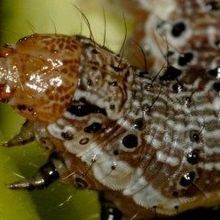Login
Subscribeplant biology, evolution

Why Did Ferns Persist When All Other Plants Perished?
Amanda Heidt | Aug 15, 2022 | 6 min read
A strange layer in the fossil record contains evidence that fern populations exploded following the mass extinction that ended the Cretaceous period. Scientists want to know why.

Meet the Algae That Went from Male/Female to Hermaphroditic
Natalia Mesa, PhD | Aug 1, 2022 | 2 min read
A study suggests that several species of brown algae may have independently evolved to express both sexes simultaneously, and it’s likely that female algae evolved male traits—not the other way around.

Sunflowers’ Bee-Attracting Ultraviolet Also Helps Retain Moisture
Natalia Mesa, PhD | Feb 8, 2022 | 5 min read
The dual purposes of the plants’ hidden colors may conflict as the climate warms, authors of a new study suggest.

Contrary to Common Belief, Some Older Trees Make Fewer Seeds
Annie Melchor | Nov 1, 2021 | 2 min read
An analysis of more than half a million trees reveals that many species begin to taper off seed production once they hit a certain size.

Discovered: Fossilized Spores Suggestive of Early Land Plants
Ruth Williams | Aug 12, 2021 | 3 min read
Spores found in 480 million-year-old rock bring the fossil record in line with molecular estimates of when plants first adapted to life on land.

Picozoans Are Algae After All: Study
Christie Wilcox, PhD | May 6, 2021 | 5 min read
Phylogenomics data place the enigmatic plankton in the middle of the algal family tree, despite their apparent lack of plastids—an organelle characteristic of all other algae.

Specialized Leaves Keep This Plant’s Fruit Warm
Shawna Williams | Feb 1, 2021 | 4 min read
A volunteer nature guide teamed up with researchers to discover a unique reproductive role for one vine’s leaves.

Genomics Reveals How Humans Can Inadvertently Drive Plant Mimicry
Shawna Williams | Mar 1, 2020 | 4 min read
Hand weeding of fields spurred an interloper to evolve a rice-like appearance, researchers conclude.

Generations of Insect Attacks Drive Plants to “Talk” Publicly
Ashley Yeager | Mar 1, 2020 | 4 min read
Goldenrods that evolved in the presence of herbivores release volatile chemicals that trigger defenses in neighboring plants of their species, even those that are genetically unrelated.

Oldest Green Algae Fossil Discovered in China
Kerry Grens | Feb 25, 2020 | 2 min read
The 1-billion-year-old impressions have features similar to modern algae and indicate that photosynthesizing plants evolved at least that long ago.

Genes from Bacteria Likely Aided Plants’ Move to Land
Shawna Williams | Nov 15, 2019 | 2 min read
An analysis suggests that DNA cribbed from soil microbes enabled plants’ ancestors to colonize a terrestrial environment.

Image of the Day: Flood Protection
Catherine Offord | Oct 31, 2018 | 1 min read
Aphids induce their host plants to produce tiny hairs that help keep the surfaces water-repellent.

Fossilized Beetle Is Earliest Evidence of Insect Pollinator
Abby Olena, PhD | Aug 16, 2018 | 3 min read
A 99-million-year-old beetle preserved in amber alongside grains of pollen likely pollinated prehistoric plants.

Image of the Day: Watering Hole
Sukanya Charuchandra | Aug 8, 2018 | 1 min read
A new study describes an unusual water harvesting method in plants.

An Enduring Partnership
Bob Grant | Feb 1, 2018 | 2 min read
Humanity would be nothing without plants. It’s high time we recognize their crucial role in sustaining life on Earth.

Insects Are Increasingly Evolving Resistance to Genetically Modified Crops
Ashley P. Taylor | Oct 13, 2017 | 2 min read
Plantings of non-GM refuges counter the development of resistance.

Distantly Related Conifers Share a Surprising Number of Cold-Tolerance Genes
Ben Andrew Henry | Dec 1, 2016 | 2 min read
Spruce and pine and have relied on similar genetic toolkits for climate adaptation despite millions of years of evolution.

How Plants Evolved Different Ways to Make Caffeine
Ruth Williams | Sep 20, 2016 | 3 min read
Caffeine-producing plants use three different biochemical pathways and two different enzyme families to make the same molecule.

Pesticide Resistance in a Plant Organelle Drives Down Whole-Genome Diversity
Catherine Offord | Aug 1, 2016 | 2 min read
A chloroplast mutation has dramatically affected the genomes of railside populations of Arabidopsis thaliana.
